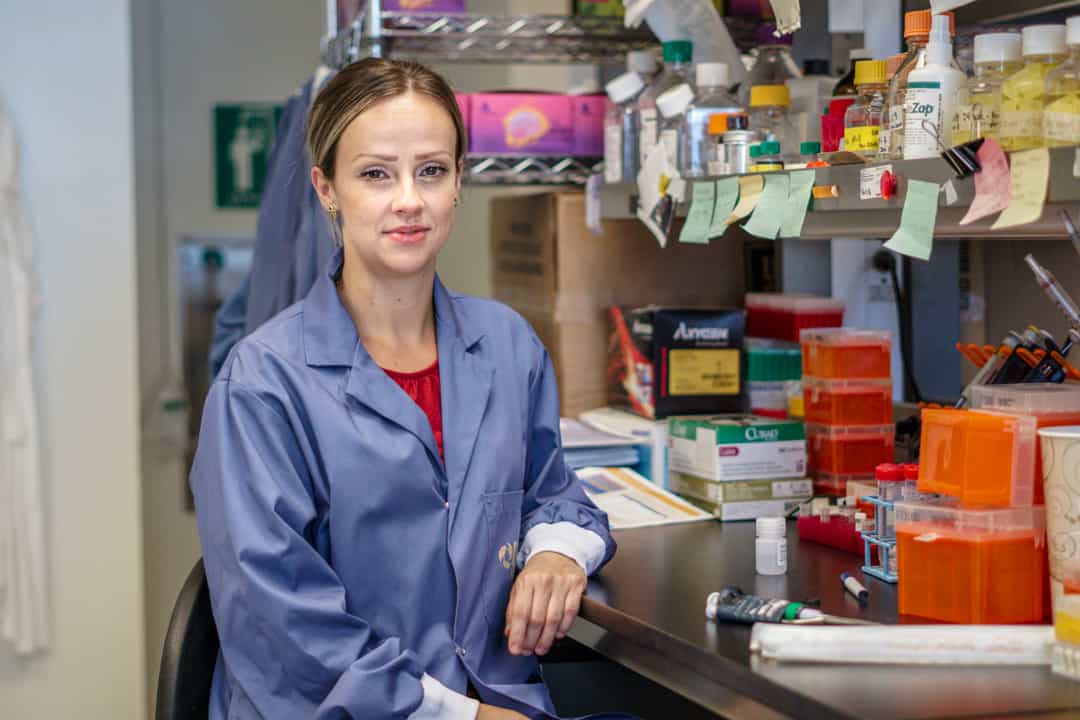Gabriela Krivdova, a graduate student from U of T’s Department of Molecular Genetics, studies blood stem cells under the supervision of Dr. John Dick. Her research may improve our understanding of leukemia, a human cancer that affects our blood and bone marrow.
“Failed experiments and rejected hypotheses”
Krivdova studies what makes blood stem cells different from mature blood cells, such as red and white blood cells. Her lab also aims to uncover the similarities and differences between healthy and cancerous blood cells by applying lab techniques used by geneticists.
While Krivdova remembers always liking the study of biology and chemistry, she recalled that her path to PhD candidacy was specifically sparked by her interest in immunology and genetics, which she developed during her undergraduate studies.
Her fascination with how the immune system works, as well as the complexity of the molecular mechanisms within our cells, led her to complete a Master’s degree at U of T under the supervision of Dr. Kathi Hudak.
Her research with Hudak was a rewarding experience that further solidified her interest in molecular biology research, and led Krivdova to her current position as a PhD student in Dick’s lab.
The biggest challenge that Krivdova faced stems from the regular prospect of failure associated with scientific research.
“I learned to not become discouraged from failed experiments or rejected hypotheses,” she noted. She added that unexpected findings are often learning opportunities.
The change in perspectives of women in science
“I must say that I am very lucky to be in the lab I am in and work with so many amazing people,” Krivdova wrote. “I have not felt or experienced any challenges associated with my gender.”
While Krivdova has not personally experienced gender-related challenges in the workplace, she considers female scientist Rosalind Franklin to be her greatest inspiration.
“There are many [inspirations that I have],” wrote Krivdova, “but Rosalind Franklin comes to my mind as she did some pioneering work on the molecular structure of DNA and viruses during the time when scientific discoveries were dominated by men.”
Franklin was a chemist whose work in developing X-ray diffraction photographs was vital in the discovery of DNA’s structure. However, molecular biologists James Watson and Francis Crick saw Franklin’s photographs of X-ray diffraction without her knowledge.
These photographs proved crucial to their discovery of the double-helix structure of DNA, but neither scientist acknowledged Franklin’s work in their announcement published in Nature.
Watson and Crick both went on to receive the Nobel Prize in Physiology or Medicine in 1962 while Franklin remains officially uncredited.
Today, female scientists are more welcome in research. Krivdova noted how she’s been happy to see an increase in the number of female undergraduate and graduate students studying the sciences at U of T in recent years.
Krivdova has also seen a rise in gender and ethnic diversity in undergraduate laboratory classes which she instructs as a TA.
A piece of advice she would have given to herself as an undergraduate, she added, would be to focus on “the bigger picture in concepts,” and avoid dwelling on the little details of her coursework.
For women considering a career in scientific fields, Krivdova’s advice is to not give up and to continue pursuing their passions.
“Keep pursuing your interests,” she wrote. While there may be disappointments or failures along the way — whether it be from failed experiments or declined scholarships — her experience has shown that hard work pays off, and that there are always fascinating ideas to research as a scientist.


